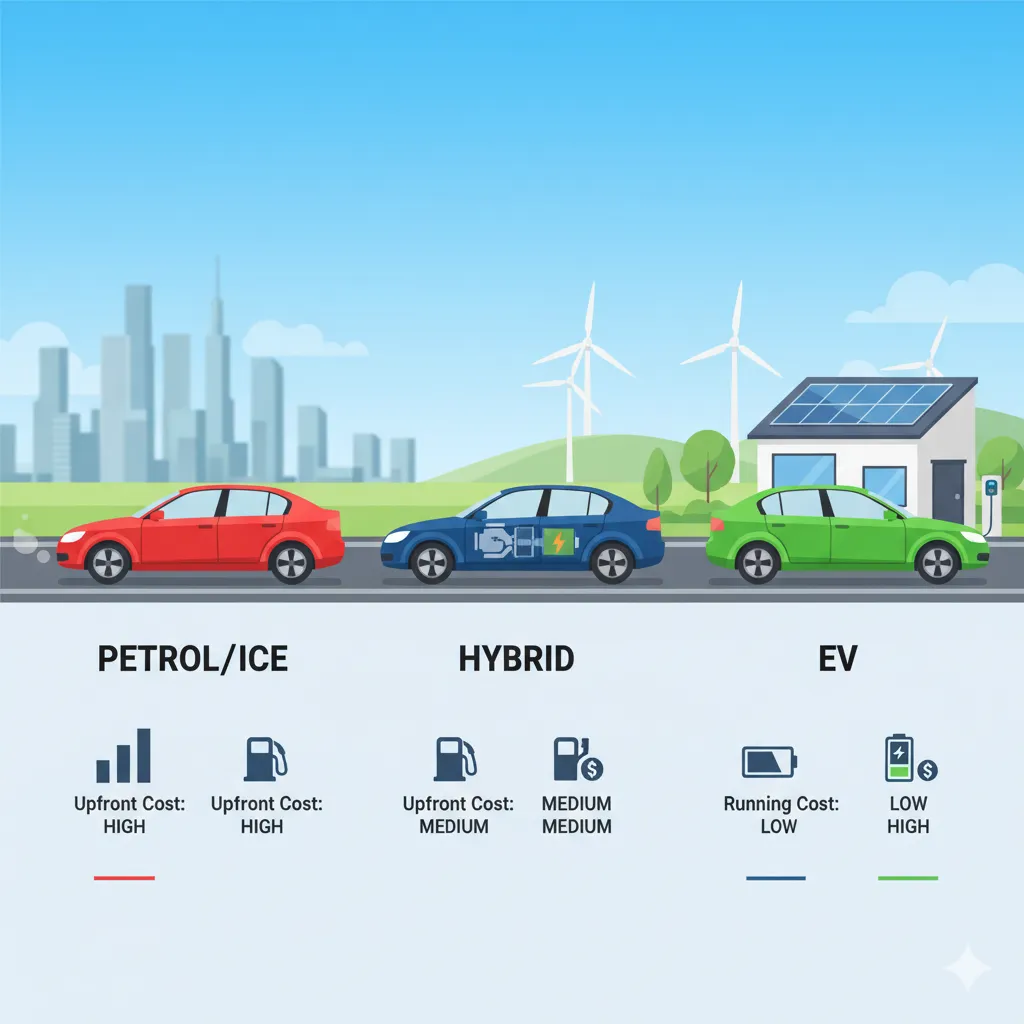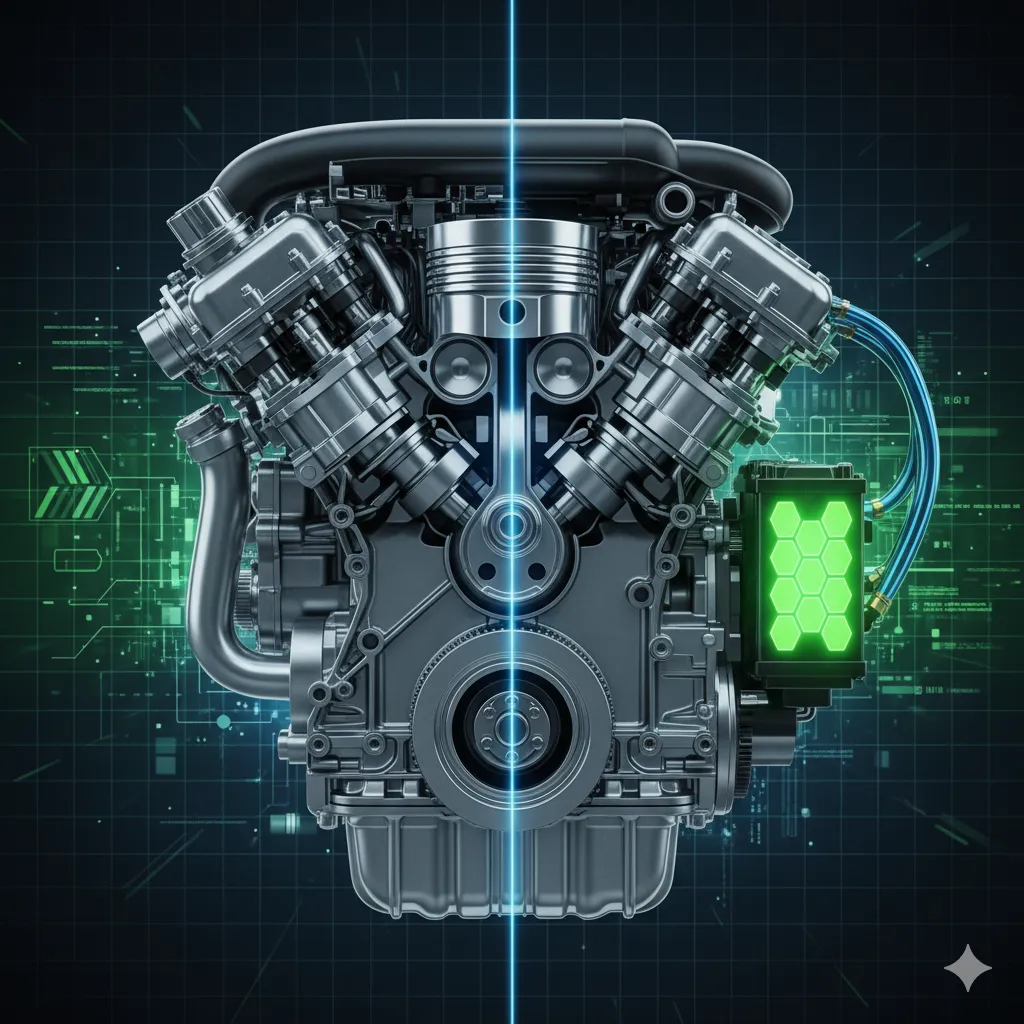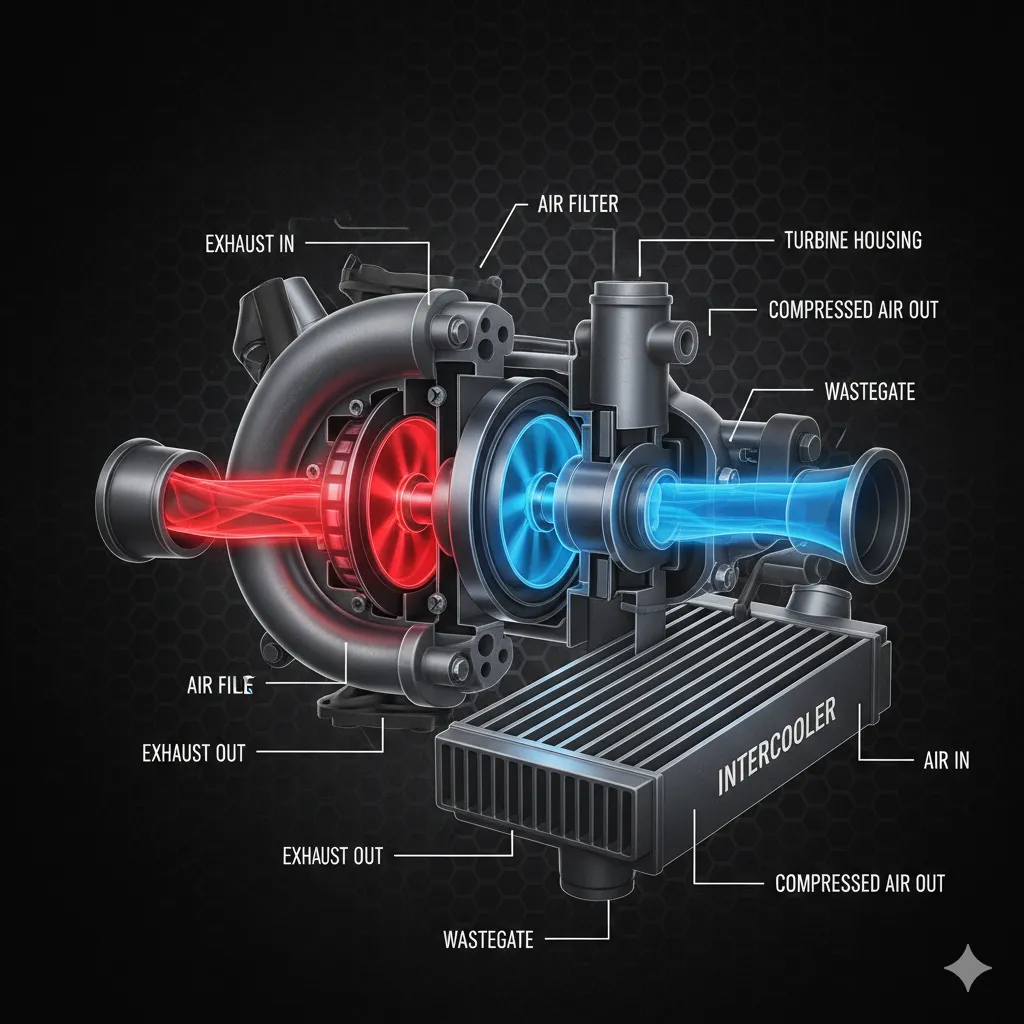
EV vs Hybrid vs Petrol: The Ultimate Car Comparison Guide
EV vs Hybrid vs Petrol: The Ultimate Car Comparison Guide
The journey toward a sustainable future begins on the road. As traditional petrol (gasoline) cars face increasing scrutiny and regulation, two powerful alternatives—Electric Vehicles (EVs) and Hybrid cars—have surged into the mainstream. But for the average car buyer, the choice is far from simple.
Are you looking for zero tailpipe emissions and minimal maintenance? Or do you value the low upfront cost and widespread refueling network of a classic engine? Perhaps you want a blend of both.
This comprehensive guide breaks down the core differences between the three main powertrains: Electric Vehicles (EVs), Hybrid Vehicles (HEVs/PHEVs), and Internal Combustion Engine (ICE) or Petrol Cars. We’ll analyze the total cost of ownership (TCO), environmental impact, performance, and infrastructure to help you choose the vehicle that fits your lifestyle and budget.
1. Core Technology: How They Work
Understanding the mechanics is the first step in the great car comparison. Each vehicle type uses a fundamentally different method to put power to the wheels.
Internal Combustion Engine (ICE) / Petrol Cars
The tried-and-true workhorse of transportation.
-
Engine: Relies solely on a combustion engine where gasoline (petrol) is ignited to create power.
-
Fuel Source: Liquid fuel (petrol) stored in a tank.
-
Emissions: Produces tailpipe emissions (CO2, NOx, particulates) from burning fuel.
-
Key Feature: Requires frequent oil changes and complex engine maintenance.
Hybrid Electric Vehicle (HEV)
A bridge between old and new technology.
-
Powertrain: Combines a smaller petrol engine with an electric motor and a small battery pack.
-
Operation: The electric motor assists the petrol engine, allowing the engine to run more efficiently. The battery is primarily recharged via the engine and regenerative braking (recovering energy when slowing down).
-
Plug-in Hybrid Electric Vehicle (PHEV): A variation with a larger battery that must be plugged in to charge, offering a limited, all-electric range (typically 20–50 miles) before the petrol engine takes over.
-
Emissions: Produces fewer tailpipe emissions than a petrol car due to electric assistance and engine-off idling, but is not zero-emission.
Electric Vehicle (EV)
The fully modernized choice, also known as a Battery Electric Vehicle (BEV).
-
Powertrain: Powered exclusively by one or more electric motors drawing energy from a large rechargeable battery pack.
-
Fuel Source: Electricity, charged by plugging into an external power source (home or public charger).
-
Emissions: Zero tailpipe emissions, making them the cleanest choice for local air quality.
-
Key Feature: Simple, single-speed transmission and significantly fewer moving parts than a combustion engine.
2. Total Cost of Ownership (TCO) Analysis
When comparing EV vs Hybrid vs Petrol, the initial purchase price is only one part of the equation. Total Cost of Ownership (TCO) considers all expenses over the vehicle's lifespan, which often flips the script.
Initial Purchase Price
Fuel / Charging Costs
The most dramatic long-term savings are found here.
-
Petrol/ICE: Highest running cost due to fluctuating and generally rising fuel prices.
-
Hybrid: Substantially lower fuel cost than petrol cars, as the electric motor assists. PHEVs can offer almost zero fuel cost for short daily commutes if charged regularly.
-
EV: Lowest running cost. Electricity is cheaper and more stable than gasoline. Per mile, charging an EV is often 3 to 5 times cheaper than fueling a petrol car. Using off-peak home charging rates maximizes these savings.
Maintenance and Servicing
EVs win hands down in the maintenance department.
-
Petrol/ICE: Highest maintenance. Requires regular oil changes, spark plug replacements, and has a complex exhaust system and transmission prone to wear.
-
Hybrid: Mid-Range/High. Still requires the full maintenance of a petrol engine (oil, filters) plus the electrical system maintenance, though regenerative braking reduces wear on brake pads.
-
EV: Lowest maintenance. No oil changes, no spark plugs, no exhaust systems. The electric motor is a sealed unit with far fewer moving parts. Fewer brake pad replacements thanks to regenerative braking.
Over a 5-year period, lower running and maintenance costs often make the EV's Total Cost of Ownership competitive with, or even lower than, a comparable petrol or hybrid car.
3. Performance, Range, and Refueling
Practicality for daily driving and long-distance travel is a critical factor for many buyers.
Driving Experience
-
Petrol/ICE: Familiar feel, audible engine noise, immediate throttle response.
-
Hybrid: Smooth transition between electric and petrol power, often quiet at low speeds.
-
EV: Instant torque means rapid, exhilarating acceleration. The ride is exceptionally smooth and quiet.
Driving Range and Refueling Time
Range Anxiety (the fear of running out of charge) is diminishing as EV range increases and the charging infrastructure expands. However, for drivers who frequently take unplanned, very long trips in remote areas, the petrol car or a non-plug-in hybrid still offers the highest convenience.
4. Environmental Impact: Emissions and Sustainability
For many, the environmental footprint is the single most important metric in this EV vs Hybrid vs Petrol debate.
Tailpipe Emissions
-
Petrol/ICE: High CO2 and air pollutant emissions.
-
Hybrid: Moderate CO2 and pollutant emissions (significantly reduced, especially in city driving).
-
EV: Zero tailpipe emissions (a massive win for urban air quality).
Lifetime (Well-to-Wheel) Emissions
While EVs have zero tailpipe emissions, the entire life cycle must be considered: from raw material mining to vehicle disposal.
-
Petrol/ICE: High emissions from both manufacturing and continuous fuel burning.
-
Hybrid: Lower lifetime emissions than petrol, as the electric components reduce fuel consumption.
-
EV: Studies consistently show that an EV’s total lifetime emissions are lower than a comparable petrol car, even when accounting for battery manufacturing. As electricity grids transition to cleaner, renewable sources (solar, wind), the lifetime carbon footprint of the EV continues to shrink.
The takeaway is clear: while EV battery production is carbon-intensive, the enormous savings from years of zero-emission driving quickly surpass the environmental impact of a petrol car.
5. Decision Factors: Which One Is Right for You?
The best choice depends on your specific driving habits, access to charging, and budget priorities.
Choose an Electric Vehicle (EV) if:
✅ Your daily commute is under 100 miles. ✅ You can install a home charger (Level 2) or have reliable charging at work/nearby. ✅ Your priority is the lowest long-term running costs (fuel and maintenance). ✅ You want zero tailpipe emissions and the quietest, smoothest drive.
Choose a Hybrid Vehicle (HEV/PHEV) if:
✅ You often drive long distances but still want to save on fuel. ✅ You want a transition vehicle to electric, but aren't ready to rely on public charging. ✅ You primarily drive in the city (where the electric motor is most effective). ✅ You value the "best of both worlds"—electric efficiency with petrol range backup.
Choose a Petrol/ICE Vehicle if:
✅ Your priority is the lowest possible upfront purchase price. ✅ You frequently drive extremely long distances in areas with little or no EV charging infrastructure. ✅ You plan to sell the car in a few years and aren't focused on maximum TCO savings.
Frequently Asked Questions (FAQs)
Q1: Is an EV or a Hybrid cheaper to insure?
A: Historically, EVs have been slightly more expensive to insure due to higher initial purchase prices and the specialized nature of their components. However, this gap is closing rapidly. Insurance costs vary widely, so it's essential to get quotes for the specific EV, Hybrid, or Petrol model you are considering.
Q2: What is "Regenerative Braking" and how does it help Hybrids and EVs?
A: Regenerative braking is a system that captures the kinetic energy that is normally wasted as heat when a car brakes or slows down. Instead of just using the friction brakes, the electric motor acts as a generator, slowing the car and sending that recovered energy back into the battery. This significantly improves efficiency for both EVs and Hybrids and reduces wear on the physical brake pads.
Q3: How long do EV and Hybrid batteries last?
A: Most manufacturers offer warranties on EV batteries that guarantee a certain capacity (e.g., 70% to 80%) for 8 years or 100,000 miles. In reality, most EV and Hybrid batteries are lasting well beyond this and are then repurposed for second-life applications (like home or grid energy storage) before being fully recycled.
Conclusion
The shift in the automotive landscape from Petrol to Hybrid to full EV is accelerating, but there is no single "perfect" choice for every driver.
Petrol/ICE cars remain the most affordable to buy upfront and offer unparalleled flexibility for long, unplanned journeys. Hybrids provide an excellent transitional technology, drastically cutting down on fuel consumption without introducing range anxiety.
However, for the vast majority of drivers with predictable commutes and access to home charging, the Electric Vehicle emerges as the clear winner in the long run. With the lowest operating costs, minimal maintenance, and the greatest environmental benefit, the EV is rapidly becoming the smarter, more future-proof choice in the world of personal transportation.
e) External Links
-
US Department of Energy - Alternative Fuels Data Center (AFDC): (For factual data on energy and emissions)
-
Environmental Protection Agency (EPA) - Green Vehicle Information: (For authoritative data on environmental impact)
-
A leading global automotive manufacturer's official blog/page on electrification: (For industry perspective and market trends)




